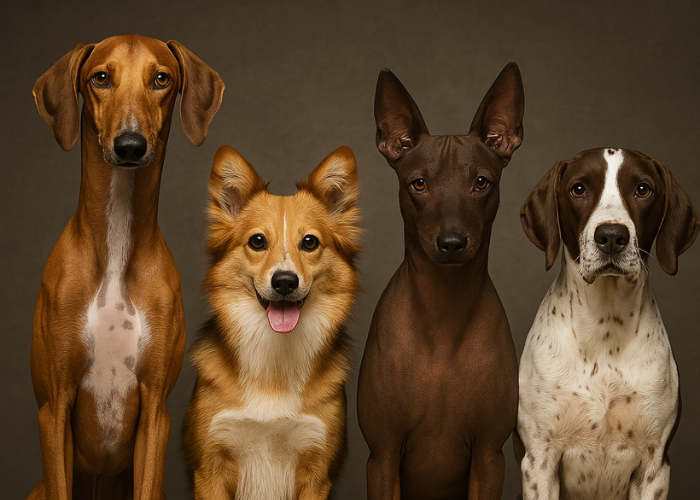The canine sense of smell is one of the greatest wonders of the animal kingdom. It’s no surprise that dogs are often referred to as “walking noses.” With an olfactory ability estimated to be between 10,000 and 100,000 times more powerful than that of humans, dogs perceive the world primarily through scents. This remarkable skill makes them indispensable in various fields, from detecting substances to assisting in medical diagnoses.
In this article, we will take an in-depth look at how a dog’s sense of smell works, what makes it so special, and how this ability can be utilized to improve their lives and those of their owners.
The Canine Nose: A Masterpiece of Nature
A dog’s nose is an incredible piece of biological engineering, designed to maximize scent detection in every possible way.
A Surplus of Olfactory Receptors
Humans have approximately 5 million olfactory receptors, whereas dogs possess between 220 million and 300 million, depending on the breed. This massive difference allows them to detect an exponentially greater number of odor molecules in the air.
Optimized Internal Structures
Inside a dog’s nose, specialized structures called nasal turbinates significantly increase the surface area available for scent detection. These turbinates help in distinguishing and identifying different odor molecules with astonishing precision.
The Vomeronasal Organ: Sensing More Than Just Smells
Beyond regular olfaction, dogs have a vomeronasal organ (also known as Jacobson’s organ), which specializes in detecting pheromones. This enables them to perceive information about the emotional state, health, and even reproductive availability of other animals.
How Does a Dog’s Sense of Smell Work?
The process of scent detection in dogs is both efficient and highly detailed.
Odor Separation
Dogs have the unique ability to separate individual scents in a complex environment. For example, while a human may smell a freshly baked cake as a single aroma, a dog can differentiate between the scents of sugar, flour, eggs, and even subtle traces of other ingredients.
Simultaneous Breathing and Smelling
A dog’s nose is designed to allow breathing and scent detection at the same time. This means that even while running or playing, they continue to process olfactory information from their surroundings.
A Brain Built for Smelling
The part of a dog’s brain dedicated to analyzing smells is about 40 times larger than that of a human, relative to body size. This explains why they can process scent information with such incredible accuracy.
Why Is a Dog’s Sense of Smell Important?
Smell is not just a powerful sense for dogs; it is an essential tool for survival and interaction with the world.
Social Recognition
Dogs use their sense of smell to recognize animals and people. They can remember an individual’s scent for months or even years, which explains their excitement when reuniting with someone they love.
Danger Detection
In the wild, a dog’s ancestors relied on their sense of smell to identify predators, locate prey, and avoid dangerous situations. Today, this skill is harnessed in search-and-rescue operations.
Well-being and Mental Stimulation
Sniffing and scent-based activities play a crucial role in a dog’s mental health. Games involving scent detection stimulate their brains and help reduce stress and anxiety.
Breeds with the Best Sense of Smell
Not all dog breeds have the same olfactory capabilities. Some stand out due to their exceptional scent-tracking skills.
- Bloodhound: Considered the best scent tracker in the world, capable of following a scent trail for long distances and extended periods.
- Beagle: Small but mighty, often used in airports to detect illegal substances.
- German Shepherd: Frequently employed in police and military operations due to their intelligence and keen sense of smell.
- Labrador Retriever: Popular in medical diagnostics and drug detection, thanks to their excellent noses and gentle temperament.
How to Stimulate Your Dog’s Sense of Smell
Encouraging your dog to use its sense of smell is a great way to keep it mentally engaged and happy.
Scent Games
- Hide treats around your home or yard and encourage your dog to find them.
- Use interactive toys that conceal food to challenge their sniffing abilities.
Walks in Diverse Environments
Taking your dog to different locations such as parks, trails, and beaches exposes them to a variety of scents, enriching their olfactory experience.
Snuffle Mats
These mats have compartments for hiding treats, providing an excellent way to train their sense of smell while also entertaining them.
Fascinating Facts About a Dog’s Sense of Smell
- Disease Detection: Dogs can detect cancer, diabetes, and even epileptic seizures before they occur, thanks to their ability to sense chemical changes in the human body.
- Emotion Sensing: They can perceive human emotions through scent-related hormonal changes, such as cortisol and adrenaline levels.
- Unique Nose Prints: Just like human fingerprints, every dog’s nose print is unique.
Conclusion
A dog’s sense of smell is an extraordinary ability that shapes how they experience the world. This skill not only makes them unique but also highly valuable in various fields, from public safety to healthcare.
As pet owners, it is crucial to appreciate and nurture this natural talent. Providing opportunities for dogs to use their noses enhances their well-being and strengthens the bond between them and their owners. Whether through scent-based games, exploratory walks, or training exercises, engaging with a dog’s olfactory world is a surefire way to ensure a happier and healthier life for your four-legged friend.
Frequently Asked Questions
- Why do dogs have such a strong sense of smell? Dogs have millions of olfactory receptors, specialized nasal structures, and a brain optimized for scent detection, all of which contribute to their superior smelling ability.
- Do all dog breeds have the same level of olfaction? No, breeds like Bloodhounds, Beagles, and German Shepherds have more advanced olfactory capabilities due to their genetics and nasal anatomy.
- How do dogs recognize people by scent? They identify the unique odor of each individual, which consists of specific skin, sweat, and environmental molecules.
- Can I train my dog to improve its sense of smell? Yes, activities like treat-finding games and using snuffle mats can enhance a dog’s natural scent-detecting skills.
- Can dogs smell things humans can’t? Absolutely. Dogs can detect odor molecules in incredibly low concentrations, making them capable of sensing smells completely undetectable to humans.



